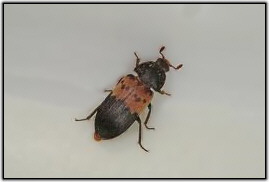Larder Beetle

The Larder beetle is found worldwide. It is widely distributed in Canada where it is a common minor pest in households. It feeds on the remains of other insects and products of animal origin such as hides, furs, skins, feathers, processed and dried meats, cheese, wool, and dried fish. It also feeds on vegetable products with high protein. It is frequently found in grain storage areas where it feeds on the remains of other insects.
The Larder beetle is a minor pest in grain storage. Both the adult and larvae feed on materials of animal origin. They also feed in spoiled grain residues, where they are likely feeding on insect remains. The larvae burrow into the commodity to feed leaving holes. They also bore into solid materials such as wood, mortar or soft metal, to pupate, which can damage storage buildings or containers. A sign of infestation is contamination with cast skins and the remains of the adult beetles.
![]()
Identification
The adult is long, oval and covered in dense hairs. It is slightly flattened and has clubbed antennae. It is 7 to 9mm long. It is dark brown to black with a wavy pale buff band across the elytra. There are three black spots on each elytron. Its underside is covered in hair. Adult longevity is 60 to 90 days. Adults can fly.
 Breeding and Development
Breeding and Development
Ideal breeding conditions are temperatures between 15°C and 30°C and a relative humidity of 40%. The female lays eggs randomly on the food source. If the female has access to water, she can increase the number of eggs she lays.
The larvae are yellow-brown and cylindrical. It is long and can become up to 20mm long when it is full-grown. It is covered with dense hairs. It can be distinguished from other Dermestid beetles by the appearance of two small horn-like structures at the tip of the abdomen. The larvae will seek a pupation site and then pupate in the last larval skin.
![]()
Ideal conditions for development are a temperature between 18°C and 20°C and a relative humidity of 80%. In these conditions, development can take 45 days. The larvae can slow its development if ideal conditions are not present.

